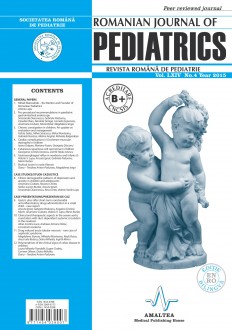SELECT ISSUE

Indexed

| |

|
|
|
| |
|
|
|

|
|
|
|
|
|
|
HIGHLIGHTS
National Awards “Science and Research”
NEW! RJP has announced the annually National Award for "Science and Research" for the best scientific articles published throughout the year in the official journal.
Read the Recommendations for the Conduct, Reporting, Editing, and Publication of Scholarly work in Medical Journals.
The published medical research literature is a global public good. Medical journal editors have a social responsibility to promote global health by publishing, whenever possible, research that furthers health worldwide.
MANIFESTARI CLINICE IN PERIOADELE DE APLAZIE SECUNDARA CHIMIOTERAPIEI
Zsuzsanna Erzsebet Papp and Maria-Adriene Horvath
REZUMAT
Obiectiv. Evidenţierea semnelor şi simptomelor clinice ale aplaziilor medulare secundare chimioterapiei anticanceroase de atac.
Material şi metodă. Lotul de studiu cuprinde 20 copii (9 luni-18 ani) spitalizaţi în compartimentul hematooncologie pediatrică al Spitalului Clinic Judeţean Mureş – secţia clinică de Pediatrie, cu următoarele diagnostice: Leucemia acută limfoblastică – LAL, tumoră Wilms – WT, Leucemie acută mieloblastică – LAM, Limfom Hodgkin – LH, Limfom cu celule mari anaplastice non-Hodgkin – LNH, tumoră cu celule mici rotunde desmoplazice – TD, Neuroblastom presacrat tratat şi recidivate – NB. Criteriul de includere în studiu a fost chimioterapia de atac, iar de excludere tratamentul citostatic de întreţinere. S-a alcătuit un protocol de supraveghere clinico-biologică în dinamică, adresat cu precădere reflectării clinice a aplaziilor induse de fiecare bloc citostatic. Aplazia medulară a fost atestată de prezenţa neutropeniei, anemiei şi trombocitopeniei.
Rezultate şi discuţii. În studiu s-au încadrat 20 copii (9 fete, 11 băieţi) cu tratament intens citostatic. Patologia majoritară a fost LAL (60%), apoi a urmat WT (3 cazuri) şi câte un caz de LAM, LH, LNH, TD, NB. Vârsta copiilor era cuprinsă între 9 luni şi 18 ani (VM-7.18), distribuţia grupelor de vârstă respectând datele din literatura de specialitate. Toţi pacienţii au fost trataţi conform protocoalelor internaţionale. După fiecare bloc citostatic a urmat o perioadă de aplazie. Patologia aferentă a constat din anemii, trombocitopenii, mucozită, infecţii cu diferite lo ca lizări, reactivare zona zoster secundară imunodeprimării.
Concluzii. Aplazia medulară postcitostatică a avut durată şi severitatea diferită în funcţie de tipul de cancer. Durata, severitatea complicaţiilor clinice şi rezistenţa la tratament au fost severe în LAL şi leucemia mieloblastică. Complicaţiile infecţioase au evoluat cu nuanţe individualizate generate probabil de particularităţile imunologice.
Cuvinte cheie: aplazie secundară, copil, chimioterapie, cancer
